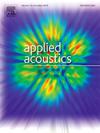Circular statistics vector for improving phase shift migration imaging of wrinkles in composites using ultrasonic array
IF 3.4
2区 物理与天体物理
Q1 ACOUSTICS
引用次数: 0
Abstract
Multilayer composites are essential for aerospace, automotive industry and medical devices, but subtle wrinkles inside will significantly impair its mechanical performance. The phase shift migration (PSM) algorithm is well-suited for imaging defects in multilayer composites due to its layer-by-layer wavefield extrapolation technique. However, it performs poorly for ultrasonic detection of wrinkles in composites because weak wrinkle echo signals are mixed and superimposed with the interlayer reflections, mechanical noise and multiple reflection waves. Based on the motivation, an imaging method of circular statistics vector factor weighted PSM (CSVF-PSM) is proposed. Firstly, the instantaneous phase of the received signal is extracted using the Hilbert transform. The cosine and sine components of the phase are abstracted into circular statistical vector (CSV). Secondly, the CSV factor (CSVF) in the frequency domain is constructed to characterize the phase distribution consistency at any pixel, which is multiplied by the original frequency domain matrix of PSM in the initial wavefield. Finally, by wavefield extrapolation, the wavefield at each layer is corrected with CSVF to obtain more accurate wavefield at different depths. The experimental results indicate that CSVF-PSM significantly improves computation efficiency compared to the conventional time-domain total focusing method (TFM) algorithm, with an improvement of at least 8.67 times. Besides, compared to PSM and sign coherence factor weighted phase shift migration (SCF-PSM), the CSVF-PSM improves the imaging clarity and texture contrast for subtle wrinkles, with the error less than 10% for the wrinkle angle detection.
圆形统计矢量改进复合材料褶皱超声阵列相移偏移成像
多层复合材料在航空航天、汽车工业和医疗设备中是必不可少的,但其内部细微的褶皱会严重影响其机械性能。相移偏移(PSM)算法采用了逐层波场外推技术,适合于多层复合材料缺陷的成像。然而,由于弱的褶皱回波信号与层间反射、机械噪声和多重反射波混合叠加,在复合材料褶皱的超声检测中表现不佳。基于这一动机,提出了一种圆形统计矢量因子加权PSM成像方法。首先,利用希尔伯特变换提取接收信号的瞬时相位;将相位的余弦和正弦分量抽象成圆形统计矢量(CSV)。其次,在频域构造CSV因子(CSVF)来表征任意像素点的相位分布一致性,并将其与初始波场中PSM的原始频域矩阵相乘;最后,通过波场外推,利用CSVF对各层波场进行校正,得到更精确的不同深度波场。实验结果表明,与传统的时域全聚焦算法(TFM)相比,CSVF-PSM显著提高了计算效率,至少提高了8.67倍。此外,与PSM和符号相干因子加权相移偏移(SCF-PSM)相比,CSVF-PSM提高了细微皱纹的成像清晰度和纹理对比度,皱纹角检测误差小于10%。
本文章由计算机程序翻译,如有差异,请以英文原文为准。
求助全文
约1分钟内获得全文
求助全文
来源期刊

Applied Acoustics
物理-声学
CiteScore
7.40
自引率
11.80%
发文量
618
审稿时长
7.5 months
期刊介绍:
Since its launch in 1968, Applied Acoustics has been publishing high quality research papers providing state-of-the-art coverage of research findings for engineers and scientists involved in applications of acoustics in the widest sense.
Applied Acoustics looks not only at recent developments in the understanding of acoustics but also at ways of exploiting that understanding. The Journal aims to encourage the exchange of practical experience through publication and in so doing creates a fund of technological information that can be used for solving related problems. The presentation of information in graphical or tabular form is especially encouraged. If a report of a mathematical development is a necessary part of a paper it is important to ensure that it is there only as an integral part of a practical solution to a problem and is supported by data. Applied Acoustics encourages the exchange of practical experience in the following ways: • Complete Papers • Short Technical Notes • Review Articles; and thereby provides a wealth of technological information that can be used to solve related problems.
Manuscripts that address all fields of applications of acoustics ranging from medicine and NDT to the environment and buildings are welcome.
 求助内容:
求助内容: 应助结果提醒方式:
应助结果提醒方式:


